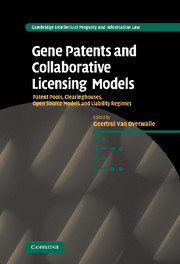 Gene Patents and Collaborative Licensing Models
Gene Patents and Collaborative Licensing Models from Part I - Patent pools
Published online by Cambridge University Press: 14 January 2010
Introduction
The presence of a patent thicket in a certain technology inevitably leads to a high number of licenses required to gain access to the patented technology. Consequently, this may result in the accumulation of royalties to be paid (royalty stacking). Such a situation may cause hindrance of access to and subsequent under-use of the technology, which is described in literature as the anticommons effect. When access and use to a certain technology are hindered by the existence of multiple patents, held by multiple patent owners (a patent thicket), a patent pool might be a useful model to facilitate access.
Patent thickets have arisen in technical fields other than the genetic area and patent pools have emerged to deal with overlapping patents for a long time. One of the first patent pools was formed in 1856, by sewing machine manufacturers Grover, Baker, Singer, Wheeler and Wilson, all accusing the others of patent infringement. They met in Albany, New York to pursue their suits. Orlando B. Potter, a lawyer and president of the Grover and Baker Company, proposed that, rather than sue their profits out of existence, they pool their patents. In 1917, an aircraft pool was privately formed encompassing almost all aircraft manufacturers, which was crucial to the US government entering World War I. In the late 1990s several patent pools were formed in the ICT branch starting with the MPEG-2 pool in 1997 for inventions relating to the MPEG-2 standard with others to follow.
To save this book to your Kindle, first ensure [email protected] is added to your Approved Personal Document E-mail List under your Personal Document Settings on the Manage Your Content and Devices page of your Amazon account. Then enter the ‘name’ part of your Kindle email address below. Find out more about saving to your Kindle.
Note you can select to save to either the @free.kindle.com or @kindle.com variations. ‘@free.kindle.com’ emails are free but can only be saved to your device when it is connected to wi-fi. ‘@kindle.com’ emails can be delivered even when you are not connected to wi-fi, but note that service fees apply.
Find out more about the Kindle Personal Document Service.
To save content items to your account, please confirm that you agree to abide by our usage policies. If this is the first time you use this feature, you will be asked to authorise Cambridge Core to connect with your account. Find out more about saving content to Dropbox.
To save content items to your account, please confirm that you agree to abide by our usage policies. If this is the first time you use this feature, you will be asked to authorise Cambridge Core to connect with your account. Find out more about saving content to Google Drive.